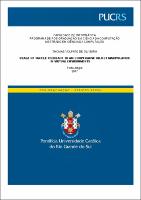| Share record |


|
Please use this identifier to cite or link to this item:
https://tede2.pucrs.br/tede2/handle/tede/8235| Document type: | Dissertação |
| Title: | Usage of tactile feedback to aid cooperative object manipulation in virtual environments |
| Author: | Oliveira, Thomas Volpato de  |
| Advisor: | Pinho, Márcio Sarroglia |
| Abstract (native): | Virtual reality is a technology that allows users to view and interact with a 3D virtual environment (VE) in real time. A collaborative virtual environment (CVE) is a type of VE that allows two or more users to be in the same virtual environment together. Collaborative virtual environments have some issues that simple VEs do not have. For example, different techniques are required in order to allow two users to manipulate (move or rotate) a virtual object together. Some of these techniques can lead users to do unnatural movements. This study evaluates haptic feedback to let users aware of wrong movements during a cooperative object manipulation. The SkeweR technique was used as a testbed. This technique is based on the use of crushing points, where the users grab the object for the first time, to simultaneously move/rotate an object. Once the users have their hands positioned on the crushing point during the object manipulation, the interaction becomes more natural, in the sense that it is more similar to the real process. However, due to the lack of any physical constraint to the users’ movements, it is often noticed that the users’ hands move away from the crushing point during the interaction. To solve this problem, this work proposes the usage of tactile feedback to inform the user about the distance between his hand and the crushing point. The tactile feedback is provided by a vibration micromotor attached to the user’s thumb. To validate the method, a user study based on the 3D manipulation of a virtual object was performed. The virtual object had to be translated and rotated through a virtual path along a virtual wire, from the beginning to the end of it. During the interaction, users manipulated a three degrees of freedom (3DOF) position tracker and were requested to keep this tracker in the same position of the crushing point. During the trials, the participants used three modalities of interaction: without any feedback, with a visual feedback and with tactile feedback. Results showed that the users do more natural manipulations when using tactile feedback. |
| Abstract (english): | Realidade virtual é uma tecnologia que permite aos seus usuários visualizar e interagir com ambientes virtuais (AV) 3D em tempo real. Um ambiente virtual colaborativo (AVC) é um tipo de AV que permite que dois ou mais usuários estejam juntos no mesmo ambiente virtual. Ambientes virtuais colaborativos têm algumas dificuldades que AV comuns não têm. Por exemplo, diferentes técnicas são necessárias a fim de permitir a dois usuários a manipulação (mover ou girar) conjunta de um objeto virtual. Algumas dessas técnicas podem levar os usuários a realizarem movimentos não naturais. Este trabalho avalia o retorno háptico para deixar os usuários cientes de movimentos errados durante a manipulação colaborativa de objetos. A técnica SkeweR foi utilizada como teste. Esta técnica é baseada em crushing points, onde os usuários pegam o objeto pela primeira vez para simultaneamente mover e girar o objeto. Uma vez que os usuários mantêm a posição da mão sobre o crushing point durante a manipulação do objeto, a interação se torna mais natural, no sentido de que se torna mais similar ao processo real de segurar um objeto. Entretanto, devido à falta de restrições físicas de movimento, frequentemente, durante a interação, a mão do usuário se move para fora do crushing point. Para solucionar este problema, este trabalho propõe o uso de retorno tátil para informar os usuários sobre a distância entre a posição da mão e o crushing point. O retorno tátil é fornecido por um minimotor de vibração preso no polegar do usuário. Para validar o método, fez-se um estudo com usuários em que estes deveriam realizar a manipulação 3D de um objeto virtual. Este objeto precisava ser transladado e girado através de um caminho virtual ao longo de um fio virtual, do início deste até o fim. Durante a interação, os usuários manipularam um rastreador de posição com três graus de liberdade (3DOF) e deveriam manter a posição do rastreador na mesma posição do crushing point. Durante as rodadas do experimento, os participantes testaram três modalidades de interação: sem nenhum retorno, com retorno visual e com retorno tátil. O resultado dos testes mostrou que usuários realizaram manipulações mais naturais quando estavam usando o retorno tátil. |
| Keywords: | Awareness Feedback Haptic Feedback 3D Manipulations Virtual Reality Retorno Háptico Manipulação 3D Realidade Virtual |
| CNPQ Knowledge Areas: | CIENCIA DA COMPUTACAO::TEORIA DA COMPUTACAO |
| Language: | eng |
| Country: | Brasil |
| Publisher: | Pontifícia Universidade Católica do Rio Grande do Sul |
| Institution Acronym: | PUCRS |
| Department: | Escola Politécnica |
| Program: | Programa de Pós-Graduação em Ciência da Computação |
| Access type: | Acesso Aberto |
| Fulltext access restriction: | Trabalho não apresenta restrição para publicação |
| URI: | http://tede2.pucrs.br/tede2/handle/tede/8235 |
| Issue Date: | 23-Aug-2017 |
| Appears in Collections: | Programa de Pós-Graduação em Ciência da Computação |
Files in This Item:
| File | Description | Size | Format | |
|---|---|---|---|---|
| THOMAS VOLPATO DE OLIVEIRA_DIS.pdf | THOMAS_VOLPATO_DE_OLIVEIRA_DIS | 2.29 MB | Adobe PDF |  Download/Open Preview |
Items in DSpace are protected by copyright, with all rights reserved, unless otherwise indicated.




